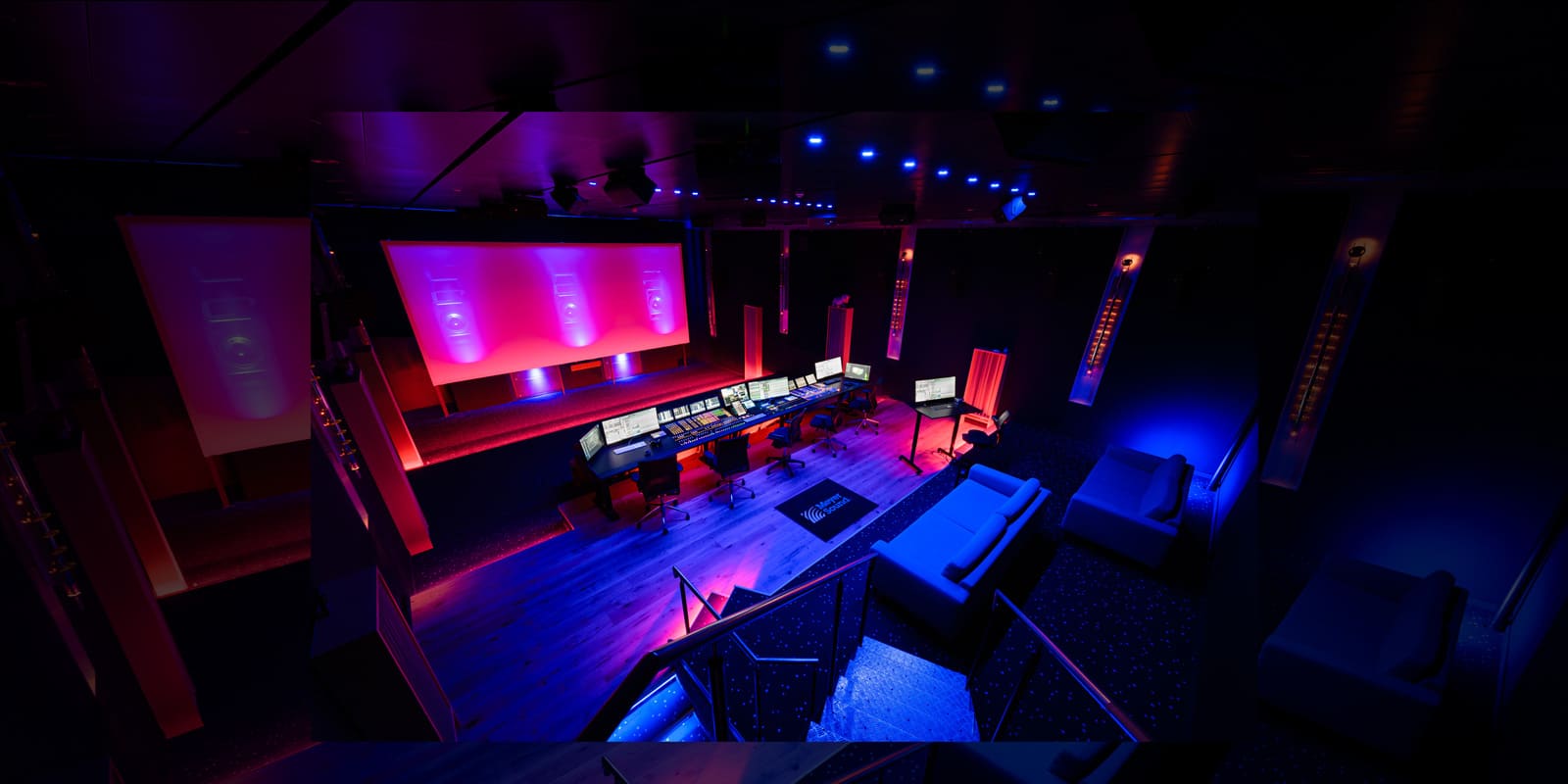Bavaria Film in Grünwald, just south of Munich, has reopened on its studio lot the legendary Studio A with a new Meyer Sound cinema loudspeaker system that marks the first deployment of the ASTRYA-140™ screen channel loudspeaker in Europe.
For nearly a century, Studio A has been a cornerstone of German cinema, the site of landmark productions such as Das Boot, The NeverEnding Story, The Name of the Rose, Stalingrad, Resident Evil and Downfall and a proving ground for new formats from Dolby Stereo via Dolby Digital to Dolby Atmos. “It was built in 1929, and German film sound was largely researched and developed here,” says project lead Michael Hinreiner, a re-recording mixer and co-founder of Haus7 • Studio, the team behind the new Studio A. Created with Timo Andert of Panoptimo GmbH and strategic advisor Daniel Vogl, Haus7 • Studio offers reference-class sound and color grading for ‘from set to screen’ workflows.
As part of the Sound Department, Studio A was long associated with Munich-based Bavaria Film and became a branch mixing location of camera and post-production giant ARRI. When ARRI sold its post-production division in 2021, it meant the end of a declining development, and in 2023, Studio A fell silent. Hinreiner worried the heritage might fade if nothing was done. “We couldn’t have that building be out of operation for another one or two or three years, because even a reputation of that scale will fade away someday. It will be just forgotten.”
Determined to bring the stage back to life, he sought supporters and found Mike Hofer founder and managing director of SMM GmbH. Hofer remembers the turning point: “We were sitting on the floor in the empty studio and said, ‘okay, we’re going to re-open this.’ It was a lot of emotion. This was the driving power, not money.”
Hinreiner had extensive experience with Meyer Sound systems, including ASTRYA’s predecessor, Acheron®, and saw the timing as serendipity. “It was really a film sound professional’s dream coming true,” he says. “It was the coming together of the right people for the right time with the right ideas at the right place. If the product had not been ready within a couple of months, we would not even have thought about it.”
Hofer adds that the room itself played a role in the project’s success. “If we would have gone to acoustic companies and said, ‘build us a room especially for those big speakers with this extra-large sound,’ it would have been just like this room. We were really lucky.”
The new cinema system is centered around ASTRYA-140 LCRs; surround coverage comes from 32 ULTRA-X20™ and two ULTRA-X40™ compact point source loudspeakers, with low-end support from two VLFC very low frequency control elements, two X-1100C™ high-power cinema subwoofers, and four USW‑112P™ compact subwoofers. Dolby Atmos serves as the primary mix format, with Galileo® GALAXY 816 processors also supporting Meyer Sound’s Spacemap® Go spatial mixing platform.
Immediately after commissioning, the system went into production on Michael Herbig’s Das Kanu des Manitu, his sequel to Der Schuh des Manitu (2001), Germany’s most successful film of all time. “It’s just so nice to be there,” says Hinreiner, who supported the project. “It’s like diving into a swimming pool that’s just the right temperature. You just have that feeling of being welcome, sound-wise.” He values the system’s agility as much as its power. “It’s not just being loud, it’s the very fast transition from the highest impacts to the lowest whispering. That energy dynamic is part of film storytelling.”
Hofer adds that the physical space enhances the experience: “The whole room sounds tight. If you hit Play, you have this massive sound coming off the walls. If you hit Stop, there is no resonance, no reverberation, nothing. Just controlled acoustics. It’s exactly like it should be.”
Hinreiner has high aspirations for Studio A. “It should be a place of collaboration,” he says. “It’s not an investor-driven place, it’s a passion-driven place. I hope it will be a creative playground for all the sound teams that can think about working on a moving picture project in Germany and all over Europe.”
With its reopening, Studio A at the Bavaria Film lot links past and present, honoring a century of film sound while introducing a new benchmark for the future. The first international ASTRYA installation underscores Meyer Sound’s commitment to cinema and establishes a new reference point for post-production facilities worldwide.
Meyer Sound In Cinema
Meyer Sound is a trusted leader in cinema loudspeaker solutions for both post-production studios and exhibition theaters. Known for precision, transparency, and dynamic range, Meyer Sound’s cinema systems deliver every sonic nuance exactly as intended by the filmmaker. With self-powered designs, advanced DSP, and seamless network integration, Meyer Sound solutions set the standard for state-of-the-art cinema sound. From our legendary work with Francis Ford Coppola, which elevated the theater experience of Apocalypse Now, to our ongoing collaborations with the leading creative forces in film sound, Meyer Sound continues to set the bar for immersive, high-fidelity experiences that honor the filmmaker’s vision, delivering sound with extraordinary power and clarity.
About Meyer Sound
Founded in 1979 by John and Helen Meyer, Meyer Sound is the global leader and innovator in self-powered loudspeaker systems, active acoustics, spatial sound mixing, and sound system design and prediction tools. Headquartered in Berkeley, California, with operations globally, the company is driven by a singular mission: to create the best sonic experiences in the world. With more than 100 patents and a legacy of breakthrough technologies—including the first dedicated loudspeaker processors and large-scale self-powered arrays—Meyer Sound combines scientific innovation with precision craftsmanship. Its premium systems power the world’s most iconic concert tours and festivals, theatrical productions, cinemas, houses of worship, educational institutions, and more. The company champions sustainable manufacturing and invests in the future of sound through education and global partnerships.





